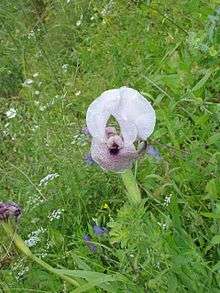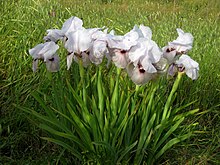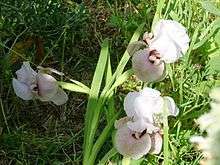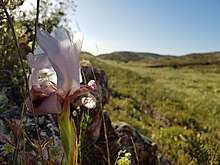Iris lortetii
Iris lortetii (also known as Lortet's iris or in Israel as the Samarian iris) is a species in the genus Iris. It has straight grey-green leaves, a 30–50 cm tall stem, and large showy flowers in late spring or mid-summer that come in shades of pink, from white, lilac, pale lavender and grey-purple. It is veined and dotted pink or maroon. It has a signal patch that is deep maroon and a sparse and brown, purple-brown or reddish beard.
| Iris lortetii | |
|---|---|
 | |
| Scientific classification | |
| Kingdom: | Plantae |
| Clade: | Tracheophytes |
| Clade: | Angiosperms |
| Clade: | Monocots |
| Order: | Asparagales |
| Family: | Iridaceae |
| Genus: | Iris |
| Subgenus: | Iris subg. Iris |
| Section: | Iris sect. Oncocyclus |
| Species: | I. lortetii |
| Binomial name | |
| Iris lortetii | |
| Synonyms[2] | |
|
Iris lortetii var. lortetii | |
Description
Iris lortetii is thought to resemble various other irises such as Iris sari, Iris gatesii, and Iris susiana,[3] and has been called perhaps the most beautiful Iris in the world.[4]
It has a short, stout rhizome,[5] that is brown and fibrous.[6] They grow just under the surface of the soil and form little complex networks.[6]
It has grey-green leaves that are straight[7] and sword-shaped.[8] It can grow to between 18–23 cm (7–9 in) long,[8] and 1–2 cm (0.39–0.79 in) wide.[5] The leaves are larger than those of Iris susiana,[9] (an iris in the same region) and they hide the flower stem.[8] It is deciduous and disappears completely during the dormancy period in winter.[6]
It has a flowering stem that is between 30–50 cm (12–19.5 in) tall.[10]
It has spathes that are 5 and 6 in (12.5 and 15 cm) long with lanceolate and pale green valves.[9]
It carries a solitary flower[8] that blooms in late spring[7] or mid-summer,[11] between April[12] and May.[5]
The large flowers are 7–9 cm (3–3.5 in) in diameter.[13] The very large showy flowers are variable in colour.[3] They can come in shades of pink,[14] from white,[15] to lilac,[5] pale lavender,[13] and grey-purple.[8]
Like other irises, it has 2 pairs of petals, 3 large sepals (outer petals) known as the 'falls', and 3 inner, smaller petals (or tepals, known as the 'standards'.[16] The falls are oblong-obovate shaped and recurved (bent backwards),[4] with maroon,[7] brown,[6] or crimson,[3] lilac to pink dots and veins on a pale blue, lavender,[3] pale cream or yellowish ground.[9] It has a small deep maroon coloured signal patch,[15] and in the middle of the falls, is a row of short hairs called the 'beard', which is sparse and brown,[11] purple-brown or reddish in colour.[5] The paler standards are orbicular shaped, with pale lilac veins on a nearly white ground.[5]
It has a purplish-brown style with reddish brown lobes,[13] and a 1.5 in (4 cm) long perianth tube.[9]
After the iris has flowered, it produces a seed capsule, which is pollinated by ants, who also disperse the seeds.[8]
Biochemistry
In 2006, it was found that the outer integument of I. lorteti and Iris confusa seeds contained a chemical compound, that was toxic to the germinated embryo. Blumentahal also found that the outer integument of I. lorteti and Iris confusa seeds contained a compound toxic to the germinated embryo. Also the iris seeds have a dormancy period of several months, this is due to mechanical resistance of the integument.[17]
As most irises are diploid, having two sets of chromosomes. This can be used to identify hybrids and classification of groupings.[16] It has a chromosome count of 2n=20.[6]
Taxonomy

It is written in Hebrew: אִירוּס הָדוּר,[12] and in Arabic: أللّغة آلعربيّة سوسن جميل.[18]
It is commonly known as 'Lortet's Iris',[19] and it also called 'Samarian Iris', although mainly in Israel.[20]
The Latin specific epithet 'lortetii' is derived from Louis Charles Émile Lortet (1836–1909) who was a French physician, botanist, zoologist and Egyptologist, he had collected the iris from the Lebanese area of the Upper Galilee, during his travels to Syria in 1880.[21]
William Barbey already described Iris lortetii but the name was validly published by Pierre Edmond Boissier in July 1882.[22]
It is sometimes incorrectly spelled as Iris lorteti, missing an i at the end of the word.[23]
I. lortetii is an tentatively accepted name by the RHS,[24] and it is listed in the Encyclopedia of Life.[25] It was verified by United States Department of Agriculture Agricultural Research Service on 4 April 2003, then updated on 1 December 2004.[26]
Iris lortetii var. samariae (Dinsm.) Feinbrun is a known and accepted variant.[27]
Distribution and habitat
Iris lortetii is native to temperate Asia.[26]
Range

It is endemic to Israel,[19] Palestine[4] and southern Lebanon,[1] (south of the Litani River[8]) and in Syria.[28]
In Israel, it is found in the regions of Upper Galilee,[15] Mount Gilboa,[5] Samarian mountains and Samarian desert.[18]
Habitat
It grows on well drained,[6] stony terra rossa, or rocky limestone slopes,[5] with open shrubland and sometimes in rock crevices on limestone cliffs.[8] It can also grow in pine forests,[29] or Mediterranean woodlands and shrubland.[12] It can be found at an altitude of 200–1,000 m (660–3,280 ft) above sea level.[9]
Conservation
Within Israel, Iris lortetii was considered in 2002 as Endangered.[15]
The overall population size of the iris is estimated to be less than 10,000 mature individuals and the count is declining. Only four small populations are known at present.[30] The Galilee populations, however, have been growing and expanding since the 1960s.[31]
Of the endangered populations, the variety 'samaria' from the northern West Bank is particularly threatened by collection from the wild with the uprooting of its rhizomes for commercial use;[30] at one time it had primarily been a cut flower, sold to customers from the roadside.[19] Large quantities of this plant were collected in the course of the 19th century and then exported to Europe, but the cultivated specimens would die after two seasons of flowering.[32] These short life spans mean that freshly collected rhizomes and plants have regularly been needed to supply the flower industry.[8] The number of individual plants have therefore declined by approximately 10% over the last ten years, and sub-populations are likely to have been lost or become extinct.[1]
Other population threats include rapid habitat destruction by afforestation.[31] The rhizomes do not like being crowded or shaded and are difficult to grow with other plants, including those that block their sunlight.[19] Iris populations can be threatened by Quercus calliprinos Webb (the Palestine oak) and Pinus halepensis Miller (the Aleppo pine).[8] In some areas, grazing by herbivorous mammals has aided survival of the iris by reducing other nearby plants.[19]
As the iris is protected by the nature conservation laws in Israel, several conservation measures have been proposed to ensure the survival of the remaining populations; these include establishment of an iris reserve and active pollination and reseeding.[8]
As the Oncocyclus Irises are difficult to maintain in cultivation, much research has been carried out, especially at the Van Tubergen Nurseries in Haarlem, Netherlands.[8] Keren Kayemet LeIsrael (KKL-JNF) carried out a study in 2012, about growing the iris from seed. Over 3,000 seeds were gathered from all the known indigenous populations, and then scientists sprouted them in greenhouse conditions with the goal of planting them in the wild later on, in the Tel Aviv University Botanical Garden. The mature plants will be planted at selected sites on KKL-JNF lands over the next three years of the study. Various thinning treatments will be carried out, in order to ensure sufficient quantities of light for healthy plants.[29]
In the southern hills of Lebanon, the status of the populations of Iris westii and I. lortetii are not known; it has been too dangerous to investigate them due to the extensive placement of explosive mines during the Israeli occupation of Southern Lebanon between 1985 and 2000.[33]
Cultivation
I. lortetii is deemed one to be one of the most difficult irises to cultivate in its class.[4] It is hardy to European Zone H4,[7] and USDA Zones 2 to 9.[11]
It prefers positions in part shade to full sun, in slightly acidic soils (with a pH level between 5 and 7.5) that are a mix of sand and clay. Like many other irises, it should be kept moist while in growth but completely dry during dormancy (winter time), and high-nitrogen fertilizer should not be given to it.[11]
In places where it is not hardy, the plant can be stored in the late summer and fall at 23 °C, which mimics the hot and dry climate of their natural Mediterranean habitat; however, the rhizomes will lose between 30 and 60% of their weight during storage.[8]
Aphid Dysaphis tulipae can be found on the plant.[34]
Propagation
Irises can generally be propagated by division,[35] or by seed growing.[29]
It was found that the force required to break seed coat is 133.2 MPa (Blumenthal et al., 1986).[36] Blumenthal et al. (1986) found different germination rates among species, from 1% to 60% seed germination in the first year for Iris lortetii Barbey and Iris atropurpurea. Also, the pressure needed to pierce the seed coat of the two species, I. lortetii and I. atropurpurea, was 135 and 77 atmospheres, respectively.[37]
Hybrids and cultivars
Iris lortetii var. samariae (Dinsm.) Feinbrun is a known variant.[27] It was published in Fl. Palaestina 4: 121 in 1986.[38] It has the synonym of Iris samariae Dinsm.,[39] and the common name of 'Samaria Iris', which in written in Hebrew: איריס הדור זן שומרוני.[40] Its description differ to Iris lortetii, in several ways such as darker standards, with brownish to purple veins on a cream coloured ground and it blooms in April. Its distribution range is found in Samaria around the city of Nablus (or Schekem) at about 800m above sea level.[5]
There is one known variety Iris lortetii 'alba' which has pure white flowers.[41]
Toxicity
Like many other irises, most parts of the plant are poisonous (rhizome and leaves), if mistakenly ingested can cause stomach pains and vomiting. Also handling the plant may cause a skin irritation or an allergic reaction.[42]
Uses
Soon after it was discovered in 1882, a lot of rhizomes were taken for commercial cultivation in Israel.[8] They were exported to Europe for the ornamental plant trade.[30] Unfortunately, the cultivated specimens rarely survived more than 2 seasons, causing a continuous demand for fresh plants and rhizomes.[19] It was also collected extensively for the cut flower industry and was sold in bunches on the side of the road, plants were also moved to decorate the cemeteries in the area.[19] It is still available locally, in Upper Galilee, Israel for sale as garden plants.[1]
Culture

An illustration of Iris lortetii has been used in 1978, as an Israeli postage stamp, part of 'Protect Wild Flowers' series.[43]
Further reading
- Danin, Avinoam (2004). Distribution atlas of plants in the Flora Palaestina area. Flora Palaestina. The Israel Academy of Sciences and Humanities. ISBN 978-9652081674.
- Mathew, B (1981). The Iris. London: BT Batford.
- Sapir, Yuval; Shmida, Avi (2002). "Species concepts and ecogeographical divergence of Oncocyclus irises". Israel Journal of Plant Sciences. 50: 119–127. doi:10.1560/DJXH-QX0M-5P0H-DLMW.
- Zohary, M; Feinbrun-Dothan, N. (1968). Feinbrun-Dothan Flora palaestina. F Palest. 67. Wiley, New Phytologist Trust. pp. 447–449. JSTOR 2430432.
References
- Sapir, Y. "Iris lortetii". IUCN Red List of Threatened Species. Retrieved 4 April 2018.
- "Iris lortetii Barbey ex Boiss. is an accepted name". theplantlist.org. 23 March 2012. Retrieved 4 April 2018.
- John Weathers The Bulb Book, p. 306, at Google Books
- Bessey, Charles E. (17 October 1913). "The Genus Iris. By William Rikatson Dykes". Science. 38 (981): 549. Retrieved 20 April 2018.
- British Iris Society (1997). A Guide to Species Irises: Their Identification and Cultivation. Cambridge University Press. p. 80. ISBN 9780521440745.
- "Chapter I (Part 5) Oncocyclus II" (in French). irisbotanique.over-blog.com. Retrieved 7 April 2018.
- Cullen, James; et al. (2011). The European Garden Flora Flowering Plants: A Manual for the Identification of Plants Cultivated in Europe, Both Out-of-Doors and Under Glass. Cambridge University Press. p. 249. ISBN 9780521761475.
- Lucas, Greg; Synge, Hugh, eds. (1978). The IUCN Plant Red Data Book: Comprising Red Data Sheets on 250 Selected Plants Threatened on a World Scale. IUCN. p. 241. ISBN 9782880322021.
- Lynch, Richard (2008). The Book of the Iris. Applewood Books. p. 111. ISBN 9781429014397.
- "Iris summary" (PDF). pacificbulbsociety.org. 14 April 2014. Retrieved 23 November 2014.
- "Iris Lortetii ( Oncocyclus Bearded Iris )". backyardgardener.com. Retrieved 26 April 2018.
- "Iris lortetii". flora.org.il. Retrieved 4 April 2018.
- Pries, Bob (18 November 2016). "(SPEC) Iris lortetii Barbey". wiki.irises.org (American Iris Society). Retrieved 4 April 2018.
- Haggett, Peter, ed. (2002). Encyclopedia of World Geography, Volume 15:The Middle East. Marshall Cavendish. p. 2089. ISBN 9780761473046.
- Kramb, D. (25 September 2004). "Iris lortetii". signa.org (Species Iris Group of North America). Retrieved 4 April 2018.
- Austin, Claire (2005). Irises A Garden Encyclopedia. Timber Press, Incorporated. ISBN 978-0881927306.
- Sun, YC; Zhang, YJ; Wang, K; Qiu, XJ (2006). "NaOH Scarification and Stratification Improve Germination of Iris lactea var chinensis seed". HortScience. 41 (3): 773–774. doi:10.21273/HORTSCI.41.3.773. Retrieved 5 April 2018.
- "Iris lortetii". wildflowers.co.il. Retrieved 4 April 2018.
- Blackhall-Miles, Robbie (4 January 2016). "Plant profile:Iris lorteti". blackhalls.co.uk. Retrieved 8 April 2018.
- "The Jordan Valley and the Samaria transition belt – summary of the Kalanit study tour". kalanit.org.il. Retrieved 11 April 2018.
- Cohen, O.; Avisham, M. (2000). "The Irises still exist: The Conservation status of species Iris Section Oncocyclus in Israel, a century after their description". Annali di Botanica. 58. Retrieved 7 April 2018.
- Boissier, Pierre Edmond (1867). Flora Orientalis: sive, Enumeratio plantarum in Oriente a Graecia et Aegypto ad Indiae fines hucusque observatarum. 5 vols. Geneva: H. Georg. p. 131.
- Blackhall-Miles, Robbie (9 May 2016). "What wild plants can teach Chelsea designers – and us". The Guardian. Retrieved 7 April 2018.
- "Iris lortetii". Royal Horticultural Society. Retrieved 4 April 2018.
- "Iris lortetii". eol.org. Retrieved 11 April 2018.
- "Iris lortetii". Germplasm Resources Information Network (GRIN). Agricultural Research Service (ARS), United States Department of Agriculture (USDA).
- "Iris lortetii var. samariae (Dinsm.) Feinbrun — The Plant List". www.theplantlist.org. Retrieved 12 November 2019.
- "Iridaceae Iris lortetii Barbey ex Boiss". International Plant Names Index. Retrieved 4 April 2018.
- "KKL-JNF Forest Research: Academics in the Field". kkl-jnf.org. 20 May 2013. Retrieved 7 April 2018.
- Spellerberg, Ian (1992). Evaluation and Assessment for Conservation: Ecological guidelines for determining priorities for nature conservation. p. 93.
- Sapir, Yuval; Smida, Avi; Fragman, Ori; Comes, H. Peter (August 2002). "Morphological variation of the Oncocyclus irises (Iris: Iridaceae) in the southern Levant". Botanical Journal of the Linnean Society. 139 (4): 369–382. doi:10.1046/j.1095-8339.2002.00067.x. Retrieved 5 April 2018.
- "Lortet's Iris". green.israel-yafa.org. Retrieved 7 April 2018.
- Saad, Layla; Khuri, Sawsan (4 August 2003). "Hanging in There by a Fall – The Oncocyclus Irises of Lebanon" (PDF). orbi.uliege.be. Retrieved 26 April 2018.
- R. L. Blackman; Victor F. Eastop (23 January 2007). Aphids on the World's Herbaceous Plants and Shrubs. Wiley. p. 554. ISBN 978-0471489733.
- "How to divide iris rhizomes". gardenersworld.com. Retrieved 12 October 2015.
- Carol C. Baskin; Jerry M. Baskin (2000). Seeds: Ecology, Biogeography, and, Evolution of Dormancy and Germination. Academic Press. p. 50. ISBN 978-0120802630.
- Dorman, Michael; Melnikov, Pavel; Sapir, Yuval; Volis, Sergei (2009). "Factors affecting dormancy of Oncocyclus iris seeds". Israel Journal of Plant Sciences. 57 (981): 329–333. doi:10.1560/IJPS.57.4.329.
- "Iridaceae Iris lortetii Barbey ex Boiss. var. samariae (Dinsm.) Feinbrun". ipni.org. Retrieved 4 April 2018.
- "Iris lortetii var. samariae (Dinsm.) Feinbrun is an accepted name". theplantlist.org. Retrieved 4 April 2018.
- "Iris lortetii var. samariae". jbg.gardenexplorer.org. Retrieved 11 April 2018.
- "Iris lortetii 'Alba'". rhs.org.uk. Retrieved 25 October 2019.
- David G. Spoerke; Susan C. Smolinske (3 July 1990). Toxicity of Houseplants. CRC Press. p. 236. ISBN 978-0849366550.
- "Israel #715 1978 Protect Wild Flowers – Iris Lortetii £1.10 Full Stamp Sheet". picclick.co.uk. Retrieved 7 April 2018.
External links
- "Images of Iris lortetii in flower". North American Rock Garden Society.
- Video of the iris in flower and habitat on YouTube
| Wikimedia Commons has media related to Iris lortetii. |
![]()
